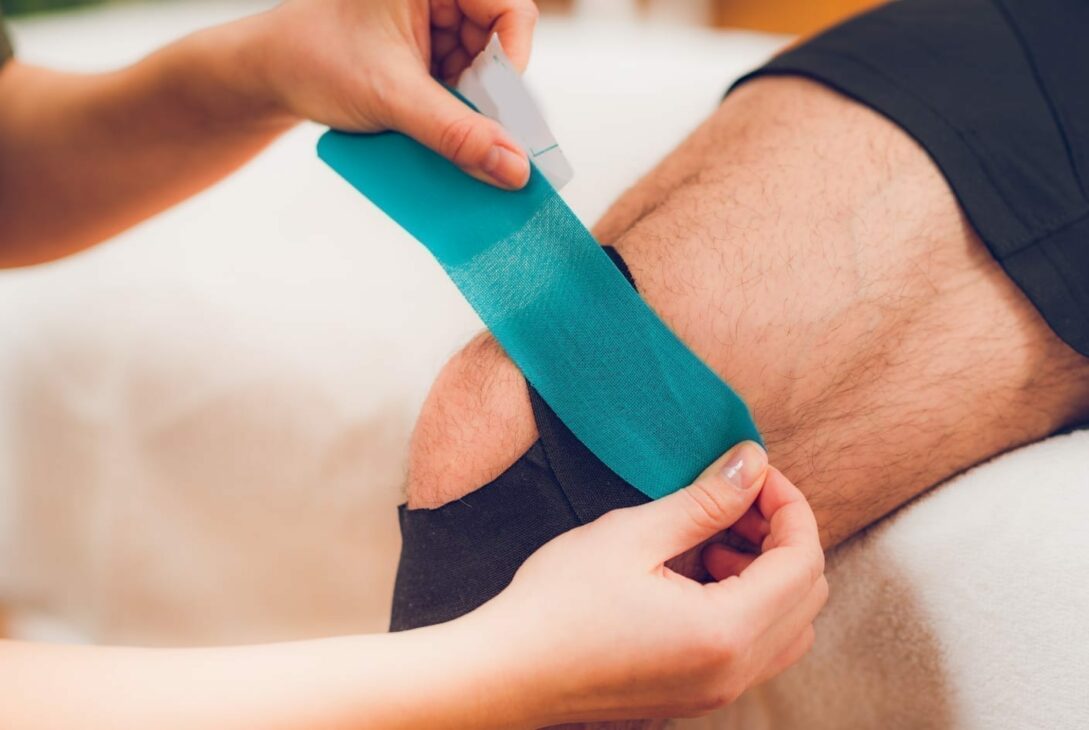Shoulder impingement syndrome is an injury and subsequent inflammation of the rotator cuff causing compression and reduced capillary blood flow. This reduced blood flow causes a fraying of the tendon tissue, causing potentially intense pain made worse by reaching up behind the back or over your head. Advanced cases of this injury could cause tearing or holes in the tendons of the rotator cuff.
Naturally, common treatments for this type of injury include application of ice to the affected areas, potential over-the-counter anti-inflammatory medications, and a physical therapy program to ensure the shoulder retains its range of motion without freezing. Physical therapy is always performed on the recommendation of a certified therapist or personal trainer, who will give you the appropriate exercises to perform. Some studies have shown that kinesiology taping can help to perform these exercises if applied correctly.
What Is Kinesiology Tape And How Can It Help?
Kinesiology tape is a very versatile, cloth-based, flexible tape that can be applied directly to affected areas of the body to assist in reducing pain and promoting muscle support. Contraction of the tape after application creates a lifting action that pulls skin away from an inflamed muscle, allowing the muscle more space to expand and move without triggering as many pain receptors in the skin.
When considering kinesiology tape in comparison to traditional athletic tape, there are a few things to keep in mind. Traditional athletic tape is considered to be a supportive tape, which is much more rigid and is not designed to move with the body. Due to kinesiology tape’s ability to stretch and move with the body while staying tight and tense, it will likely be much more comfortable and last longer when applied. While athletic tape is cheaper, its lack of breathability and stiffness can lead to skin irritation and blisters with extended use. Kinesiology tape will generally be better in these situations, and will outperform traditional tapes. It is only recommended to use athletic tape when greater amounts of support is desired, rather than allowing for movement.
By using kinesiology tape when performing shoulder exercises, you are able to better monitor your posture, coordination, and limits of your shoulder through physical cues while targeting particular muscle groups you wish to use while avoiding others. The tension in the tape acts as your guide while you are going through the necessary motions.
There are many benefits to using kinesiology tape, including potentially decreasing the overall recovery time and providing short-term pain relief. Using kinesiology tape as a guide also promotes better alignment, thereby reducing the risk of rotator cuff tears or other related injuries.
Tips For Kinesiology Tape Application
Benefits in pain reduction should be immediate upon application as the tape begins working immediately through its natural tension. If you are not experiencing these results, it could be due to improper application. This is normal for those who are initially inexperienced with taping, and it is usually recommended to have a physical therapist or personal trainer apply the taping first, a process they can usually provide assistance in explaining the process. It is often beneficial to have your therapist document the process on video to allow you to have visual cues when applying your tape. If you find it difficult to apply the tape due to some spots being out of your range of motion, it is probably best to allow the therapist to apply the tape to achieve the best results.
There are a few good general guidelines when applying kinesiology tape:
- If you have had a reaction to other adhesives with other varieties of tape in the past, avoid using kinesiology tape. Monitor yourself closely to ensure you don’t develop skin irritation and remove immediately if irritation occurs.
- As it is a tape with fairly strong adhesive, you may consider shaving any hair under the application location, as it will likely increase comfort and reduce pain due to pulling when the tape is removed.
- Measure how much tape you need prior to taping and pre-cut them, allowing for stretch in the centre of the tape. Remember that while you need some stretch for the tape to be effective, generally less stretch is better and more effective.
- Leave a couple of inches on each end of the tape, which remains unstretched to anchor your tape to desired areas.
- Kinesiology tape should not remain applied longer than five days in a row, as you need to allow your skin to breathe. Remove the tape carefully, as ripping the tape off may result in skin being removed with it.
As mentioned earlier, it is always a good idea to have a professional ensure that taping is done correctly to ensure maximal benefits. There are multiple videos online on how to apply tape for shoulder impingement, and they do provide good general guidelines on how to approach taping. Remember that each person’s physiology is unique, and the finished product may look marginally different depending on the person. Use common sense, and always consult a professional if you aren’t sure.
Author’s Bio
Colin Hegarty is a content writer for BreezeMaxWeb that helps businesses showcase their brand through enticing copy. When he’s not working, you can find him playing net in a local beer league or biking around the city.





















